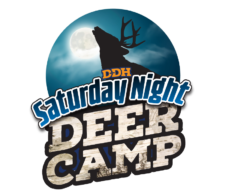Dominant buck behavior includes fighting, but it also features subtle body language that deer use throughout the year.
This video shows classic dominant buck behavior as the big buck approaches the side of a food plot. The younger buck — a yearling — instantly knows he is the insubordinate deer in this confrontation.
From a biological standpoint, these deer would not be of the same bachelor group if they were seen among a gathering of bucks in a field. True bachelor groups typically involve bucks of the the same relative age class. A dominant buck in a bachelor group isn’t always the one with the largest rack. Dominance is a complicated behavior and usually involves other things like size, strength and temperament.
Dominant Buck Behavior
Deer & Deer Hunting readers first learned of dominant buck behavior through the work of men like Leonard Lee Rue III of New Jersey. Rue was one of the first behaviorists to document when, where, why and how male whitetails fight throughout the year (especially during the rut) and how one dominant buck eventually emerges from the group.
According to Rue, bucks seldom fight with other bucks that belong to the same bachelor group. “They have associated with one another throughout the rest of the year, and dominance has already been established,” he said. “Each buck already knows where he stands. Occasionally, a younger buck might get ambitious and have to be reminded of his standing in the social hierarchy, but posturing and threats by the dominant buck usually suffice.”
When Two Bucks Meet
As is also seen in this video clip, when two white-tailed bucks meet for the first time, behavior of the insubordinate buck is often immediate if the two deer are clearly of different age classes.
Watch the yearling buck. He squats and sidles off to one side. He is almost cowering at the presence of the other, older buck. The mere size difference of these two deer is enough to send the message from the older buck that he is definitely dominant and, hence, will take precedence when it comes to this feeding area. The fact that the younger buck hangs around is an indication that summer-time encounters are much milder than what might occur in, say, October or November. Velvet antlers are very sensitive during summer. This bigger, dominant buck is going to try to get by with his attitude, hoofs and perhaps a few bluff moves to get his point across. He will not use his antlers if at all possible, because any impact would be painful to these still-growing appendages.

JOIN THE CAMPFIRE AT THE SATURDAY NIGHT DEER CAMP!
Deer & Deer Hunting invites you to our new Saturday Night Deer Camp, only on Pursuit Channel.
 Saturday Night Deer Camp is a primetime block of shows kicked off each week with the award-winning Deer & Deer Hunting TV. Hosted by Dan Schmidt, Gordy Krahn, Mark Kayser and Steve Bartylla, the show is in its 14th season and covers everything related to deer hunting, from tactics and strategy to gear, biology, great hunts and more.
Saturday Night Deer Camp is a primetime block of shows kicked off each week with the award-winning Deer & Deer Hunting TV. Hosted by Dan Schmidt, Gordy Krahn, Mark Kayser and Steve Bartylla, the show is in its 14th season and covers everything related to deer hunting, from tactics and strategy to gear, biology, great hunts and more.
Following DDH TV, you can watch Destination Whitetail, The Given Right with Kenneth Lancaster and then Land of Whitetail. These four shows make Saturday Night Deer Camp your must-watch viewing this year.
Check your local listings for Pursuit Channel. It’s also available now on AT&T U-Verse, Channel 1644, among other networks.

